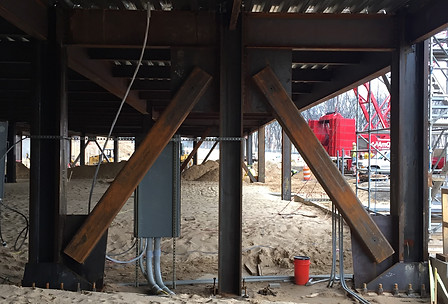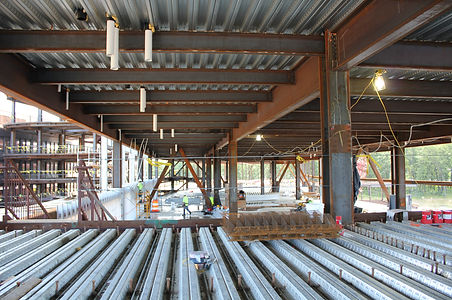Abby Severyn | Structural
Adviser: Dr. Ryan Solnosky

ThesisProposal
Structural Depth
The existing Mercy Health Muskegon gravity system will be redesigned as composite steel with fewer infill beams. A more in-depth analysis and comparison of different systems will be performed to verify that the modified composite steel design is the best choice. The comparison will utilize several different decision-making techniques, including the Analytical Hierarchy Process (AHP), Choosing By Advantages (CBA), and the Pugh Matrix (PM). The results of these comparisons will be analyzed to determine if the most beneficial system was chosen as a result of the original structural system comparisons performed in Notebook Submission B. Numerous iterations of the redesigned gravity system will also be used for a vibration analysis.
The lateral system will also undergo a redesign. Mercy Health is part of Trinity Health, which has hospital locations across the United States. The lateral system redesign will explore a theoretical location change of the Mercy Health Muskegon addition to Fort Lauderdale, Florida, an area where Trinity Health has an existing hospital. With this move to a hurricane region, the structure will be exposed to significantly higher wind loads, which will be calculated and compared to those of the existing location. While the existing structure is designed for a controlling seismic lateral load case, the lateral system will now be redesigned to accommodate increased wind loads. The redesign will consist of modifications to member sizes and to the quantity of braced and moment frames if necessary. The number of lateral frames will be evaluated to determine if any can be removed or if additional frames are required.


MAE Requirements
A detailed model of the gravity and lateral systems of the Mercy Health Muskegon addition will be created in RAM Structural System to fulfill the MAE requirements. The computer modeling with this software will build upon the modeling fundamentals discussed in AE 530: Computer Modeling of Building Structures. While this course focused on ETABS and SAP2000, the information and techniques learned will be used to become familiar with new structural modeling software. The RAM model will be used to analyze and optimize new designs for steel-framed gravity systems and lateral systems that may incorporate a combination of moment frames, braced frames, and shear walls. Additionally, the model will be used for vibration analysis of the system.

Honors Requirements
Honors thesis requirements will be met through the research and application of several multi-criteria decision-making (MCDM) methods for determining an optimal structural system for use in healthcare facilities. These MCDM methods include the Analytical Hierarchy Process (AHP), Choosing By Advantages (CBA), and the Pugh Matrix (PM). A literature review will be conducted to identify the uses of these decision-making techniques within the architecture, engineering, and construction (AEC) industry. The research will also be used to identify the benefits and challenges associated with each method and how they may affect results. A survey and discussions with professionals in the AEC industry will be the basis for the criteria used for the AHP, CBA, and PM. These MCDM methods will then be utilized to compare the various gravity systems considered for use in the Mercy Health Muskegon addition. The results of each method will be compared and used to determine if the original decision to use a modified composite steel system in the redesign was the best decision based on the specified design goals.
Honors Thesis Proposal
Breadth Topics
Construction Management: Prefabrication
Since it is becoming increasingly popular to use prefabricated elements in hospital projects, a construction management breadth with a focus on prefabrication will be investigated. This research will explore elements that have potential to be prefabricated and their feasibility based on integration with other building systems. Prefabricated components that will be investigated include but are not limited to bathrooms, patient room headwalls, and mechanical racks. After this analysis, detailed calculations will be performed to determine the effects of using prefabricated elements on the construction schedule and building cost.

Mechanical: Acoustics
The Mercy Health Muskegon hospital was designed for patient-centered care, and acoustics are a significant concern for the privacy and well-being of patients. As a mechanical breadth, an acoustic analysis will be executed for the floor, wall, and ceiling assemblies in a typical patient room to determine the sound characteristics and acoustical performance. Based on the acoustic analysis results, suggestions will be made for potential opportunities to improve the acoustical performance and determine the benefits and challenges associated with these changes. Acoustical performances of proposed new assemblies will be compared to those of the existing design to see how the changes affect the overall performance.


